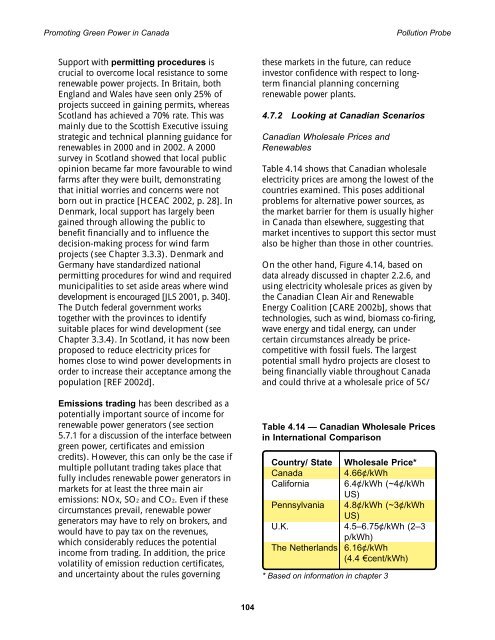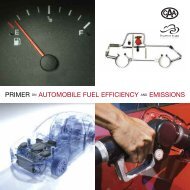Promoting Green Power in Canada - Centre for Human Settlements
Promoting Green Power in Canada - Centre for Human Settlements
Promoting Green Power in Canada - Centre for Human Settlements
- No tags were found...
You also want an ePaper? Increase the reach of your titles
YUMPU automatically turns print PDFs into web optimized ePapers that Google loves.
<strong>Promot<strong>in</strong>g</strong> <strong>Green</strong> <strong>Power</strong> <strong>in</strong> <strong>Canada</strong> Pollution ProbeSupport with permitt<strong>in</strong>g procedures iscrucial to overcome local resistance to somerenewable power projects. In Brita<strong>in</strong>, bothEngland and Wales have seen only 25% ofprojects succeed <strong>in</strong> ga<strong>in</strong><strong>in</strong>g permits, whereasScotland has achieved a 70% rate. This wasma<strong>in</strong>ly due to the Scottish Executive issu<strong>in</strong>gstrategic and technical plann<strong>in</strong>g guidance <strong>for</strong>renewables <strong>in</strong> 2000 and <strong>in</strong> 2002. A 2000survey <strong>in</strong> Scotland showed that local publicop<strong>in</strong>ion became far more favourable to w<strong>in</strong>dfarms after they were built, demonstrat<strong>in</strong>gthat <strong>in</strong>itial worries and concerns were notborn out <strong>in</strong> practice [HCEAC 2002, p. 28]. InDenmark, local support has largely beenga<strong>in</strong>ed through allow<strong>in</strong>g the public tobenefit f<strong>in</strong>ancially and to <strong>in</strong>fluence thedecision-mak<strong>in</strong>g process <strong>for</strong> w<strong>in</strong>d farmprojects (see Chapter 3.3.3). Denmark andGermany have standardized nationalpermitt<strong>in</strong>g procedures <strong>for</strong> w<strong>in</strong>d and requiredmunicipalities to set aside areas where w<strong>in</strong>ddevelopment is encouraged [JLS 2001, p. 340].The Dutch federal government workstogether with the prov<strong>in</strong>ces to identifysuitable places <strong>for</strong> w<strong>in</strong>d development (seeChapter 3.3.4). In Scotland, it has now beenproposed to reduce electricity prices <strong>for</strong>homes close to w<strong>in</strong>d power developments <strong>in</strong>order to <strong>in</strong>crease their acceptance among thepopulation [REF 2002d].Emissions trad<strong>in</strong>g has been described as apotentially important source of <strong>in</strong>come <strong>for</strong>renewable power generators (see section5.7.1 <strong>for</strong> a discussion of the <strong>in</strong>terface betweengreen power, certificates and emissioncredits). However, this can only be the case ifmultiple pollutant trad<strong>in</strong>g takes place thatfully <strong>in</strong>cludes renewable power generators <strong>in</strong>markets <strong>for</strong> at least the three ma<strong>in</strong> airemissions: NOx, SO2 and CO2. Even if thesecircumstances prevail, renewable powergenerators may have to rely on brokers, andwould have to pay tax on the revenues,which considerably reduces the potential<strong>in</strong>come from trad<strong>in</strong>g. In addition, the pricevolatility of emission reduction certificates,and uncerta<strong>in</strong>ty about the rules govern<strong>in</strong>gthese markets <strong>in</strong> the future, can reduce<strong>in</strong>vestor confidence with respect to longtermf<strong>in</strong>ancial plann<strong>in</strong>g concern<strong>in</strong>grenewable power plants.4.7.2 Look<strong>in</strong>g at Canadian ScenariosCanadian Wholesale Prices andRenewablesTable 4.14 shows that Canadian wholesaleelectricity prices are among the lowest of thecountries exam<strong>in</strong>ed. This poses additionalproblems <strong>for</strong> alternative power sources, asthe market barrier <strong>for</strong> them is usually higher<strong>in</strong> <strong>Canada</strong> than elsewhere, suggest<strong>in</strong>g thatmarket <strong>in</strong>centives to support this sector mustalso be higher than those <strong>in</strong> other countries.On the other hand, Figure 4.14, based ondata already discussed <strong>in</strong> chapter 2.2.6, andus<strong>in</strong>g electricity wholesale prices as given bythe Canadian Clean Air and RenewableEnergy Coalition [CARE 2002b], shows thattechnologies, such as w<strong>in</strong>d, biomass co-fir<strong>in</strong>g,wave energy and tidal energy, can undercerta<strong>in</strong> circumstances already be pricecompetitivewith fossil fuels. The largestpotential small hydro projects are closest tobe<strong>in</strong>g f<strong>in</strong>ancially viable throughout <strong>Canada</strong>and could thrive at a wholesale price of 5¢/Table 4.14 — Canadian Wholesale Prices<strong>in</strong> International ComparisonCountry/ State<strong>Canada</strong>Cali<strong>for</strong>niaPennsylvaniaWholesale Price*4.66¢/kWh6.4¢/kWh (~4¢/kWhUS)4.8¢/kWh (~3¢/kWhUS)U.K. 4.5–6.75¢/kWh (2–3p/kWh)The Netherlands 6.16¢/kWh(4.4 €cent/kWh)* Based on <strong>in</strong><strong>for</strong>mation <strong>in</strong> chapter 3104
















